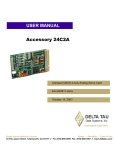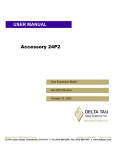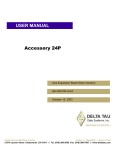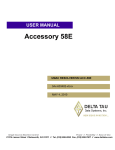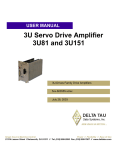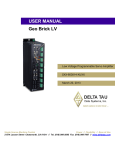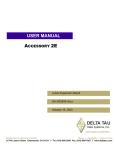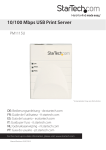Download Delta Tau 3U AMP-1 User's Manual
Transcript
^1USER MANUAL ^2 AMP 1 ^3 40W 4-Channel Linear Brush Motor ^4 3Ax-603489-xUxx ^5 August 22, 2006 Single Source Machine Control Power // Flexibility // Ease of Use 21314 Lassen Street Chatsworth, CA 91311 // Tel. (818) 998-2095 Fax. (818) 998-7807 // www.deltatau.com Copyright Information © 2003 Delta Tau Data Systems, Inc. All rights reserved. This document is furnished for the customers of Delta Tau Data Systems, Inc. Other uses are unauthorized without written permission of Delta Tau Data Systems, Inc. Information contained in this manual may be updated from time-to-time due to product improvements, etc., and may not conform in every respect to former issues. To report errors or inconsistencies, call or email: Delta Tau Data Systems, Inc. Technical Support Phone: (818) 717-5656 Fax: (818) 998-7807 Email: [email protected] Website: http://www.deltatau.com Operating Conditions All Delta Tau Data Systems, Inc. motion controller products, accessories, and amplifiers contain static sensitive components that can be damaged by incorrect handling. When installing or handling Delta Tau Data Systems, Inc. products, avoid contact with highly insulated materials. Only qualified personnel should be allowed to handle this equipment. In the case of industrial applications, we expect our products to be protected from hazardous or conductive materials and/or environments that could cause harm to the controller by damaging components or causing electrical shorts. When our products are used in an industrial environment, install them into an industrial electrical cabinet or industrial PC to protect them from excessive or corrosive moisture, abnormal ambient temperatures, and conductive materials. If Delta Tau Data Systems, Inc. products are exposed to hazardous or conductive materials and/or environments, we cannot guarantee their operation. REVISION HISTORY REV. 1 DESCRIPTION E-POINT JUMPER & AMP SPEC REVISIONS DATE CHG APPVD 08/22/06 CP R. UNADKAT Amp 1 Table of Contents INTRODUCTION ........................................................................................................................................ 1 Power Supply Considerations .................................................................................................................... 1 Selecting Current vs. Voltage Mode .......................................................................................................... 1 Maximum Current Output E-Point Jumpers.......................................................................................... 1 Amplifier-Enable/Fault Polarity Selection ............................................................................................ 2 Torque/Velocity Control ............................................................................................................................ 2 HARDWARE DESCRIPTION ................................................................................................................... 3 TB1: 8-Pin PMAC Interface Terminal Block ............................................................................................ 3 TB2: 13-Pin Motor Amplifier Output Terminal Block .............................................................................. 3 TB3: External Power Ground..................................................................................................................... 3 TB4: External Power.................................................................................................................................. 3 TB5: External Logic Power........................................................................................................................ 4 P1: 96 Pin Power Input Connector ............................................................................................................. 4 Amplifier Specifications ............................................................................................................................ 5 Power Stage Specifications.................................................................................................................... 5 Mechanical Specifications ..................................................................................................................... 5 Environmental ....................................................................................................................................... 5 Amplifier User Components Description................................................................................................... 5 Fuses...................................................................................................................................................... 5 LEDs...................................................................................................................................................... 5 Offset Pots ............................................................................................................................................. 6 SAMPLE WIRING DIAGRAM.................................................................................................................. 7 ANALOG AMPLIFIER BACKPLANE BOARD ..................................................................................... 9 Single Quad H-Bridge Amplifier Backplane Layout ................................................................................. 9 Dual Quad H-Bridge Amplifier Backplane Layout.................................................................................. 10 Table of Contents i Amp 1 INTRODUCTION The Amp 1 Linear Amplifier is a 3U-size amplifier designed to drive small DC brushed type motors or proportional hydraulic valve actuators. This amplifier provides four 40W continuous (60W intermittent) linear amplifiers. The Amp 1 Linear Amplifier may be interfaced conveniently to the PMAC controller via Acc-24E2A. The maximum bus voltage for this amplifier is 24VDC and the continuous rating for each drive is 0.5A. The amplifiers on this product will output a current or voltage that is proportional to the voltage input. The amplifier can receive its logic power supply (_15V) from the 3U-power supply and the bus voltage is supplied from a separate supply. Power Supply Considerations The Amp 1 Linear Amplifier requires a single power supply of +12V to +24V max. The current requirement can vary depending on the load, but should not exceed 4A (1A per channel) continuous and 8A peak (2A per channel) for a one-second period. A slow blow 5A fuse is installed to protect the shunt and a fast acting 8A fuse to protect the main bus. If the amplifier is driven beyond its rated power, driver overheating may occur. In this event, the driver will output a fault signal on the corresponding pin of Terminal Block 2 (TB2) and turn on the corresponding red LED next to Terminal Block 1, TB1, shown in the Amplifier Layout Diagram. Selecting Current vs. Voltage Mode The Amp 1 Linear Amplifier can be configured in either current or voltage mode. This is configured by setting the following E-point jumpers. Maximum Current Output E-Point Jumpers Each of the amplifiers has an E-point jumper that allows changing the transconductance factor of the amplifier. Jumper E1A E1B E1A & E2 No jumper Description Channel 1 Setup Jumper 1-2 Current Mode with gain of 0.2 A/V Jumper 1-2 Current Mode with gain of 0.04 A/V Jumper 1-2 Voltage Mode with gain of 1V in = 2.6V out Jumper 1-2 Current Mode with gain of 0.02 A/V Default X Channel 2 Setup E3A E3B E3A & E4 No jumper Jumper 1-2 Current Mode with gain of 0.2 A/V Jumper 1-2 Current Mode with gain of 0.04 A/V Jumper 1-2 Voltage Mode with gain of 1V in = 2.6V out Jumper 1-2 Current Mode with gain of 0.02 A/V X Channel 3 Setup E5A E5B E5A & E6 No jumper Jumper 1-2 Current Mode with gain of 0.2 A/V Jumper 1-2 Current Mode with gain of 0.04 A/V Jumper 1-2 Voltage Mode with gain of 1V in = 2.6V out Jumper 1-2 Current Mode with gain of 0.02 A/V X Channel 4 Setup E7A E7B E7A & E8 No jumper Introduction Jumper 1-2 Current Mode with gain of 0.2 A/V Jumper 1-2 Current Mode with gain of 0.04 A/V Jumper 1-2 Voltage Mode with gain of 1V = 2.6V out Jumper 1-2 Current Mode with gain of 0.02 A/V X 1 Amp 1 Jumpers are provided to lower the current output rating either 200 or 400mA, for motors with smaller current needs. Effectively, this cuts the amplifier transconductance factor in half, allowing use of the full +10V from PMAC’s DAC outputs rather than scaling the system to output +2V via Ix69. Note: If the amplifier is driving a DC motor at high speeds, the current supply to the motor may be reduced if the back EMF voltage of the motor is sufficiently large (refer to the motor manufacture’s data sheet). Amplifier-Enable/Fault Polarity Selection The controller (PMAC or UMAC) should be configured for low-true amplifier-enable signals. A green LED next to Terminal Block 1 (TB1) for each amplifier on the 3U linear amplifier is lit when the board is receiving power and that amplifier is enabled. Also, if the amplifier fault signal is fed back to PMAC, bit 23 (the most significant bit) of Ix25 (PMAC) or bit 23 of Ix24 for Turbo PMAC should be set to zero for Low True fault input. The red LED for each channel is lit when the amplifier faults (overheats). Torque/Velocity Control For direct torque or velocity control, the following I-variables may be adjusted as part of the motor software setup (Example for PMAC2-Turbo): Ixx00 Ixx02 Ixx03 Ixx04 Ixx24 Ixx25 Ixx69 Set to 1 to activate motor. Motor xx Command Output Address. For example: I102=$078003 to use DAC1 with motor 1. Motor xx Position Loop Feedback Address. For example: I103=$3501 to use Encoder 1. Motor xx Velocity Loop Feedback Address. For example: I104=$3501 to use Encoder 1. Set motor xx Flag Mode Control. For example: I124=$100001 to specify high true fault input. Set motor xx Flag Address. For example: I125=$078000 to specify channel 1 flags. Set motor xx Output Command Limit. Refer to the Turbo PMAC/PMAC2 Software Reference Manual for full descriptions of these I-variables. 2 Introduction Amp 1 HARDWARE DESCRIPTION There are six connectors on the QUAD H-Bridge Amplifier board: • TB1: 8-Pin PMAC Interface Terminal Block • TB2: 13-Pin Motor Amplifier Output Terminal Block • TB3: External Power Ground • TB4: External Bus Power • TB5: External logic power • P1: 96-Pin Power Input Connector TB1: 8-Pin PMAC Interface Terminal Block This terminal block provides the actual connection to the motors. Pin Symbol Function 1 2 3 4 5 6 7 8 AMPOUT1 AMPOUT1/ AMPOUT2 AMPOUT2/ AMPOUT3 AMPOUT3/ AMPOUT4 AMPOUT4/ Output Output Output Output Output Output Output Output Description First Motor + Lead First Motor - Lead Second Motor + Lead Second Motor - Lead Third Motor + Lead Third Motor - Lead Fourth Motor + Lead Fourth Motor - Lead TB2: 13-Pin Motor Amplifier Output Terminal Block This connector brings in up to four analog command signals and amplifier-enable lines. It also sends the amplifier fault signal back to the controller. Pin Symbol Function 1 2 3 4 5 6 7 8 9 10 11 12 13 DAC1+ AENA1FAULT1DAC2 AENA2FAULT2AGND DAC3 AENA3FAULT3DAC4 AENA4FAULT4- Input Input Output Input Input Output Input Input Output Input Input Output Description Notes Command Signal 1 Amplifier Enable 1 Amplifier Fault 1 Command Signal 2 Amplifier Enable 2 Amplifier Fault 2 Analog Ground Command Signal 3 Amplifier Enable 3 Amplifier Fault 3 Command Signal 4 Amplifier Enable 4 Amplifier Fault 4 Reference to AGND Reference to AGND Reference to AGND Reference to AGND Reference to AGND Reference to AGND Reference to AGND Reference to AGND Reference to AGND Reference to AGND Reference to AGND Reference to AGND TB3: External Power Ground Pin Symbol Function 1 PGND Input Description Bus power reference TB4: External Power Pin Symbol Function 1 A+24V Input Hardware Description Description Bus power reference 3 Amp 1 TB5: External Logic Power Pin Symbol Function 1 2 3 4 AGND A+15V AGND A-15V Input/Output Input Input/Output Input Description Reference for logic supply For logic power (usually from backplane) Reference for logic supply For logic power (usually from backplane) P1: 96 Pin Power Input Connector 4 Pin# Row A Row B Row C 1 2 3 4 5 6 7 8 9 10 11 12 13 14 15 16 17 18 19 20 21 22 23 24 25 26 27 28 29 30 31 32 PGND PGND PGND PGND PGND PGND PGND PGND NC +24V (bus) +24V (bus) +24V (bus) +24V (bus) +24V (bus) +24V (bus) +24V (bus) +24V (bus) NC DB R+ DB R+ DB R+ DB R+ NC DB RDB RDB RDB RNC AGND A+15V AGND A-15V PGND PGND PGND PGND PGND PGND PGND PGND NC +24V (bus) +24V (bus) +24V (bus) +24V (bus) +24V (bus) +24V (bus) +24V (bus) +24V (bus) NC DB R+ DB R+ DB R+ DB R+ NC DB RDB RDB RDB RNC AGND A+15V AGND A-15V PGND PGND PGND PGND PGND PGND PGND PGND NC +24V (bus) +24V (bus) +24V (bus) +24V (bus) +24V (bus) +24V (bus) +24V (bus) +24V (bus) NC DB R+ DB R+ DB R+ DB R+ NC DB RDB RDB RDB RNC AGND A+15V AGND A-15V Hardware Description Amp 1 Amplifier Specifications Power Stage Specifications Description Specification V+ input voltage Logic power Transconductance factor Max continuous current Peak current Command input voltage 12V minimum, 24V maximum 15V @ 100mA, -15V @ 50mA 0.2 A/V, 0.04 A/V, or 0.02 A/V 4A (1A per channel) 8A (2A per channel) +/- 10V Mechanical Specifications Size & Dimension See Diagram TB1 Connector TB2 Connector TB3 Connector TB5 Connector TB4 Connector P1 Connector 8-pin Screw Terminal 13-pin Phoenix 1-pin Screw Terminal 1-pin Screw Terminal 4-pin Screw Terminal 96-pin 3U back plane Environmental Operating Temperature 0 C to 55 C (32 F to 135 F) Storage temperature Humidity -12 C to 82 C (10 F to 180 F) 0% to 95%, non-condensing Amplifier User Components Description Fuses Label Type F1 8A Description Fast Blow for BUS LEDs Hardware Description Label Function LD1 LD2 LD3 LD4 LD5 LD6 LD7 LD8 LD10 Channel 1 Enable Channel 1 Fault Channel 2 Enable Channel 2 Fault Channel 3 Enable Channel 3 Fault Channel 4 Enable Channel 4 Fault Over Temperature Fault 5 Amp 1 Offset Pots Name A B C D 6 Label Function R6 R46 R86 R126 Channel 1 Current Offset Channel 2 Current Offset Channel 3 Current Offset Channel 4 Current Offset Hardware Description Amp 1 SAMPLE WIRING DIAGRAM Sample Wiring Diagram 7 Amp 1 8 Sample Wiring Diagram Amp 1 ANALOG AMPLIFIER BACKPLANE BOARD The analog amplifier backplane board allows easy access to power the Quad H-Bridge amplifier units when placed in the 3U racks. The amplifier backplane boards come in two options: single amplifier 2-slot assemblies or dual amplifier 4-slot assemblies. The board itself has terminal screws for the external bus, external shunt resistors, a Molex connector for the logic power, and another Molex connector for the cooling fans. Backplane Board Part Number Single Amplifier Dual Amplifier 603490-10x 603470-10x 3U Slots used 2 4 Single Quad H-Bridge Amplifier Backplane Layout Analog Amplifier Backplane Board 9 Amp 1 Dual Quad H-Bridge Amplifier Backplane Layout 10 Analog Amplifier Backplane Board
















